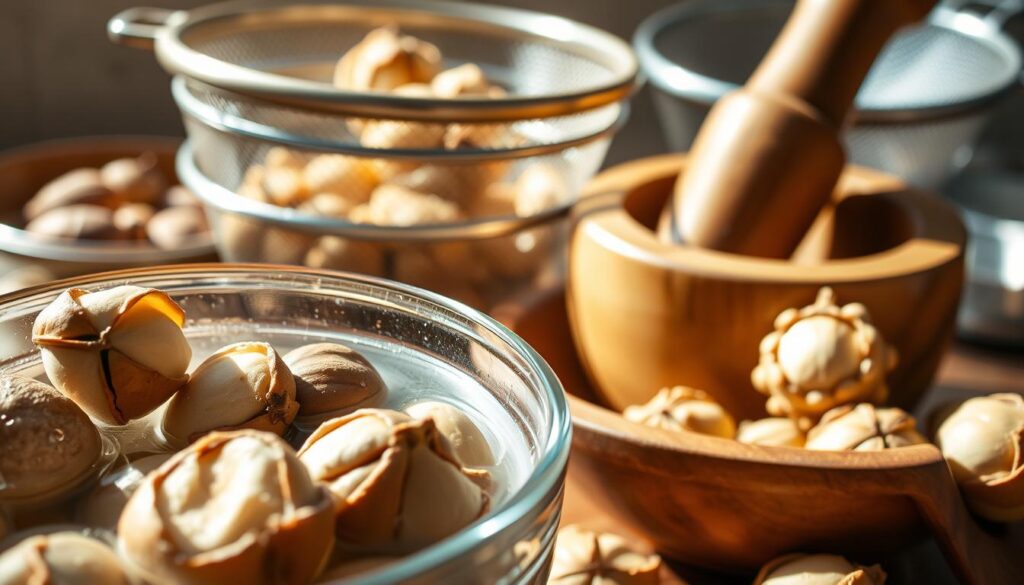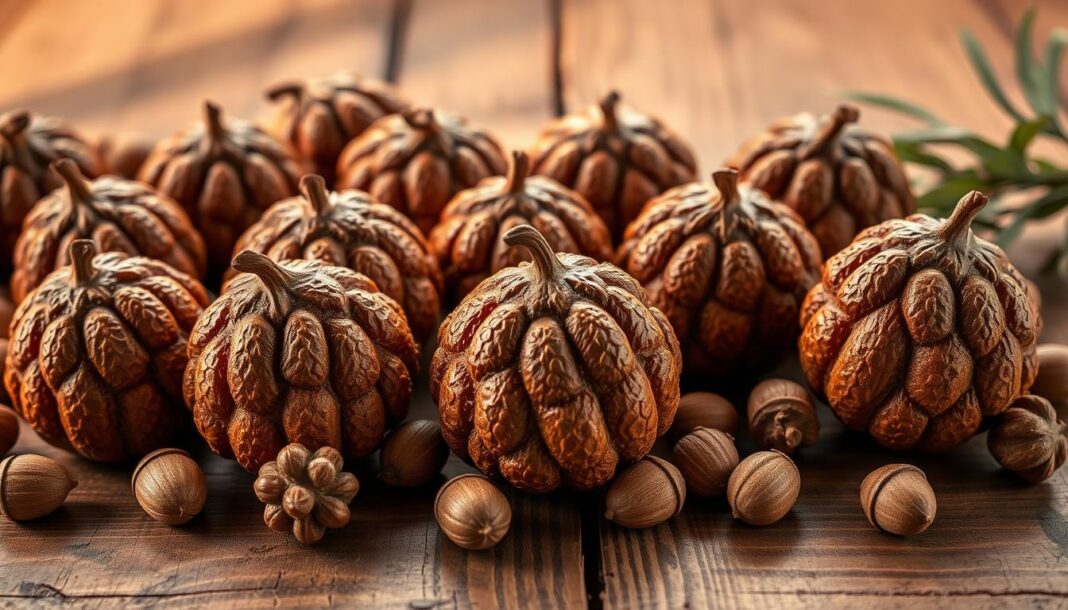Acorns from the cork oak are not only a food source for animals but have also been a staple food for many cultures throughout history. The Koreans are among the most avid consumers of acorns, using them in various traditional dishes. We explore the fascinating world of acorn cakes, a traditional treat that has been enjoyed across cultures.
We’ll guide you through the process of transforming raw acorns into a delicious cake that showcases their unique caramel-like flavor. With oak trees found worldwide, from Asia to North America, the potential for creating diverse recipes using acorns is vast. This traditional food is rich in history and culinary possibilities.
At Historical Foods, we empower home cooks with thorough testing and detailed explanations. Our comprehensive guide will walk you through harvesting, preparation, and baking, making the most of your time in the kitchen, working with these versatile nuts.
The Magic of Cooking with Acorns
Embracing acorns in our recipes allows us to tap into a traditional food source with significant cultural heritage. Acorns have been a crucial part of human diets across various continents, particularly before the widespread cultivation of cereal grains.
What Are Acorn Cakes?
Acorn cakes are baked goods made from processed acorn flour, which has been an essential ingredient for indigenous populations for thousands of years. The process of making acorn flour involves careful preparation to remove bitter tannins, resulting in a flour with a sweet, caramel-like flavor profile.
The Rich History of Acorns in Cuisine
Acorns have a rich history in cuisine, dating back to ancient times when they were a staple food source. The oak tree, from which acorns are derived, holds sacred significance in many cultures. Historically, acorns were consumed in large quantities until they became less favored with the advent of cereal grains. However, their nutritional benefits and unique flavor are now being rediscovered. The process of leaching acorns with water is crucial to remove tannins, making them palatable for consumption.
The transition from acorns to cereal grains marked a significant dietary shift in human history. Yet, we’re now revisiting the benefits of this traditional food. Acorn flour, lacking gluten, was historically used for flatbreads and denser cakes. Modern recipes often combine it with other flours for lighter textures, opening up new possibilities for recipes involving acorn flour.
Preparing Acorns for Baking
To bake delicious acorn cakes, we must first prepare our acorns through a series of careful steps. This preparation is crucial for removing bitterness and bringing out the natural flavors of the acorn.
Harvesting and Selecting Quality Acorns
Harvesting acorns requires careful selection. We look for nuts that are brown, firm, and free from holes or visible damage, ideally collecting them soon after they’ve fallen from the tree in autumn. Quality acorns will have caps that detach easily and will feel heavy for their size.
Leaching Process to Remove Tannins
The leaching process is critical for removing bitter tannins that make raw acorns inedible. This can be done through multiple cold water rinses or hot water methods. Cold water leaching preserves more nutrients and produces a milder flavor, while hot heat methods are faster but may result in some nutrient loss.

| Leaching Method | Time Required | Nutrient Preservation |
|---|---|---|
| Cold Water Leaching | Several days | High |
| Hot Water Leaching | 2-3 hours | Moderate |
Making Acorn Flour
After leaching, we thoroughly dry the acorn meal before grinding it into a fine flour, known as acorn flour. It’s essential to make sure the meal is dry to produce high-quality flour. The resulting acorn flour is suitable for baking and can be used in various recipes.
By following these steps, we can enjoy our favorite acorn cakes while appreciating the effort that goes into preparing the acorn flour from scratch.
Delicious Acorn Cakes Recipe
Now that we’ve explored the history and preparation of acorn flour, it’s time to dive into our favorite acorn cakes recipe. This recipe balances the unique earthy flavor of acorn flour with complementary ingredients that enhance its natural sweetness and create a perfectly textured cake.
Essential Ingredients
To make our acorn cakes, you’ll need a combination of ingredients that work together to bring out the best flavor and texture. The essential ingredients include acorn flour, which you’ve prepared through the leaching process, all-purpose or cake flour for structure, butter for richness, eggs for binding, and sugar to complement the natural caramel notes of the acorns.
The recipe calls for ½ cup olive oil, 1/2 cup acorn or chestnut flour, 1/2 cup cake flour or all-purpose wheat flour, ¼ cup toasted and chopped pine nuts (optional), ½ teaspoon baking powder, ½ teaspoon baking soda, 1/4 teaspoon salt, 3 separated eggs, ½ cup honey, ¼ cup sugar, and confectioner’s sugar for dusting.
| Ingredient | Quantity |
|---|---|
| Olive Oil | ½ cup |
| Acorn or Chestnut Flour | 1/2 cup |
| Cake Flour or All-purpose Wheat Flour | 1/2 cup |
| Toasted and Chopped Pine Nuts (optional) | ¼ cup |
| Baking Powder | ½ teaspoon |
| Baking Soda | ½ teaspoon |
| Salt | 1/4 teaspoon |
| Eggs | 3 separated |
| Honey | ½ cup |
| Sugar | ¼ cup |
Equipment You’ll Need
For baking our acorn cakes, you’ll need standard baking tools, including measuring cups and spoons, mixing bowls, a whisk or electric mixer, a rubber spatula, and an appropriate baking pan. Bundt pans work particularly well for acorn cakes, as they provide a beautiful shape and even baking.
Mixing the Batter
The mixing process begins with creaming butter and sugar until light and fluffy, then incorporating eggs one at a time to create an emulsion that will give your cake proper structure. When combining wet and dry ingredients, alternate additions and mix just until incorporated to avoid developing too much gluten, which can make your cake tough.
The batter should have a medium-thick consistency that drops slowly from a spoon. If it seems too thick, a tablespoon or two of milk can be added to achieve the right texture. For variations, consider folding in chopped nuts, dried fruits, or chocolate chips to complement the earthy flavor of the acorn flour and add textural interest to your cake.
Step-by-Step Baking Instructions
Baking acorn cakes requires precision and attention to detail, starting with the preparation of your baking pan. Proper preparation is crucial for ensuring that your cakes release easily and maintain their structure.
Preparing Your Baking Pan
To prepare your baking pan, start by greasing it thoroughly with butter or cooking spray. For detailed molds or crevices, use a pastry brush to ensure an even coating. Then, dust the pan with flour, tapping out any excess to prevent a thick, gummy coating on your finished cake. This step is essential for decorative pans like bundt or cakelet molds.
Baking Time and Temperature
Preheat your oven to 350°F (175°C), positioning the rack in the center for even heat distribution. Pour the batter into your prepared pan, filling it about two-thirds full. Bake for approximately 30 minutes, but keep an eye on your cakes after 20 minutes, as acorn flour browns more quickly than traditional flour.
| Baking Time | Oven Temperature | Pan Size |
|---|---|---|
| 25-35 minutes | 350°F (175°C) | Standard cake pan |
| 20-25 minutes | 350°F (175°C) | Mini cake pans |
How to Know When They’re Done
Test for doneness by inserting a toothpick or cake tester into the center of the cake. It should come out clean or with a few moist crumbs, but not wet batter. The cake should also spring back slightly when gently pressed on top. Allow the cake to cool in the pan for about 10 minutes before transferring it to a wire rack to cool completely.
As Historical Foods emphasizes, patience is key. Rushing the cooling process can cause your topping to melt or the cake to break apart if it’s still too warm. Once cooled, dust with confectioner’s sugar for a delightful finish.
Serving and Storing Your Acorn Cakes
With your freshly baked acorn cakes in hand, the next steps are to serve them in a way that highlights their unique flavor and to store them properly to maintain their freshness. For the best flavor, allow the cakes to cool completely before serving, as this allows the nutty notes to become more pronounced.
You can enjoy your acorn cakes plain or enhance them with toppings like maple glaze, cream cheese frosting, or a dusting of powdered sugar. Pairing them with fresh seasonal berries, whipped cream, or a drizzle of local honey also complements their earthy undertones.
To store, place the cakes in an airtight container at room temperature for up to three days. For longer storage, freeze unglazed cakes in a single layer in a container for up to three months. Check out more acorn cake recipes and tips on utilizing acorn flour in various recipes, from pancakes to savory dishes.


